Saron is a coal mining community, west of Ammanford in the community of Llandebie in Carmarthenshire. At the heart of the village is Saron Baptist Chapel, which contains in its grounds a war memorial which commemorates the men of the village who fell during both world wars.

World War One, 1914-1918
Rees Daniel, Lance Sergeant, 14149, Royal Welsh Fusiliers. Rees was the son of John and Mary Daniel of Gwynffrwd, Saron, and the husband of Miriam Daniel. He enlisted at Ammanford into the 11th Battalion, Royal Welsh Fusiliers, which was attached to 67 Brigade, 22nd Division. The Division moved to France in September 1915. Their stay there was short however as they were moved to Salonika by 5 November 1915, where they fought throughout the campaign there. Rees was killed in action during the Battle of Doiran, on 18 September 1918, aged 31. He is commemorated on the Doiran Memorial, Salonika.
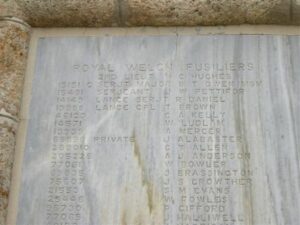
John Jones, Private, 20819, Welsh Regiment. John was born at Lampeter in 1896, the son of Mary Jones. They resided at 4, Dogsbrook Terrace, Saron prior to the war. John enlisted at Rhyl into the 15th Battalion, Welsh Regiment, which was known as the Carmarthen Pals battalion, attached to 114 Brigade, 38th (Welsh) Division. On 2 December 1915 the battalion moved to France, and the entire Division moved to the Fleurbaix sector, where it was initiated into trench warfare. On 9 March 1916, the 15th Welsh were holding the La Pannerie sector, near Cuinchy, when the Germans exploded three underground mines in their lines. John was one of seven men killed that day, with many more wounded. John was 19 years old, and is buried at Guards Cemetery, Windy Corner, Cuinchy, France.
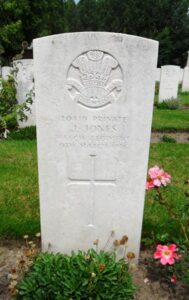
William Herbert Lewis, Lance Corporal, 103485, Royal Engineers. William was born at Ludchurch, Pembrokeshire, the son of Thomas and Mary Ann Lewis. The family later moved to 2, Gwendraeth House, Saron, Ammanford, probably for Thomas to find work in one of the numerous coal mines in the area. William followed his father into the mines after leaving school, working at Pontllanfraith when he decided to enlist into the Royal Engineers on 15 June 1915. After training, William was posted to France on 16 October 1915, and joined the 178th Tunnelling Company, Royal Engineers. The Tunnelling Companies had been set up in order to carry out the secretive and dangerous tasks of digging shafts beneath German positions in order to lay huge explosive charges, which could be blown at the launching of assaults, opening up large areas of the German front line where the British could then drive through in the hope of a breakthrough. 178th Tunnelling Company had formed on the Somme, where it carried out work in readiness for the Somme offensive of 1 July 1916. In 1918 it was involved in demolition work following the German offensives of March and April 1918, and was tasked with demolition of bridges and other vital activities. William was wounded sometime during this period, and died as a result on 28 May 1918, aged 33. William is buried at Bagneux British Cemetery, Gézaincourt, France, in Grave II. B. 13. William does not appear to be commemorated either at Ludchurch or at Saron.

Daniel Thomas, Private, S/3227, Rifle Brigade. Daniel was born at Gwynfe, the son of Isaac and Margaret Thomas. His parents later resided at Pleasant Hill Capel Hendre, Pantyffynon. Daniel married Margaret Anne Edwards on 16 June 1908, and the couple set up home at Spen Cottage, Penygroes, where their son Vincent was born. Daniel enlisted at Abertridwr on 8 September 1914 into the Rifle Brigade. On 29 July 1915 Daniel was posted to France, joining the 13th Battalion, Rifle Brigade, which was attached to 111 Brigade, 37th Division. The division saw its significant action during the diversionary attack at Gommecourt during the opening day of the Somme offensive on 1 July 1916, but due to heavy losses suffered by the 34th Division, 111 and 112 Brigades were temporarily attached to them until 22 August, 1916. Upon their return to the Division, they fought on the Ancre, and were at Arras in March 1917, where they fought at the Scarpe, capturing Monchy-le-Preux. Daniel was killed in action during the Battle of the Scarpe, on 11 April 1917, aged 27. He is commemorated on the Arras Memorial, France.
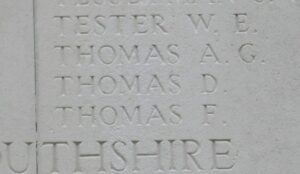
World War Two, 1939-1945
Leo Vernon Anthony, Sergeant, 1313259, Royal Air Force Volunteer Reserve. Leo was the son of John Watkin Anthony and Griselda Maud Anthony (nee Davies) of Brookford, Saron. He married Una Adams in 1942. Leo served in 153 Squadron, RAF, which had formed on 24 October 1941 at Ballyhalbert, from ‘A’ Flight of No 256 Squadron, which had moved there on 14 October from Squires Gate. It operated Defiant’s on night fighter duties until May 1942 but in December, a Blenheim arrived for training and in January the process of converting the squadron onto Beaufighter’s began in earnest. The squadron continued to provide night defence of Northern Ireland until December when it moved to North Africa, where the squadron provided night cover to Allied forces as well as providing protection to convoys from a range of advanced bases. Leo was serving at one of these advanced bases at Malta when he was killed on 23 June 1943, aged 23. He is commemorated on the Malta Memorial.
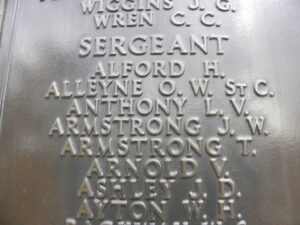
Ronald Llewellyn Anthony, Fusilier, 4209641, Royal Inniskilling Fusiliers. Ronald was the son of Willie David and Annie Mary Anthony, of Penybank, Ammanford, and served with the 6th Battalion, Royal Inniskilling Fusiliers. The Battalion was attached to the 38th Irish Infantry Brigade, and fought throughout the North African Campaign. Ronald was killed in action in North Africa on 19 July 1943, aged 21, and is buried at Medjez-El-Bab War Cemetery, Tunisia.
Oswald Morgan Atkins, Sergeant, 1317866, Royal Air Force Volunteer Reserve. Oswald was probably the son of Daniel and Annie Atkins, of Llwynon Hendre Pantyffynon. He served in 100 Squadron RAF which had been stationed in Singapore at the outbreak of war, where it was decimated during the Japanese attacks. On 15 December 1942 the Squadron reformed at RAF Waltham (Grimsby), and were equipped with Lancaster’s. On 17 August 1943, over 590 aircraft of RAF Bomber Command took off from bases over the UK, with the mission of bombing the V2 Rocket facility at Peenemunde. The mission was a success, but 40 aircraft were intercepted and shot down by German night-fighters on the return home, one of which contained Oswald. He was killed in action on 18 August 1943, aged 23, and is commemorated on the Runnymede Memorial.
Benjamin Rees Davies, Fusilier, 4196914, Royal Welch Fusiliers. Benjamin was the son of John Rees Davies and Martha Davies, of Saron, and served in the 1st Battalion Royal Welch Fusiliers. The Battalion had suffered terribly during the German invasion of France, and the remnants were evacuated from Dunkirk. Back in the U.K., it was brought back up to strength by drafting in men from other Battalions of the R.W.F., and in 1942 they sailed to the Far East to face the Japanese invasion. After a brief stop in Cape Town they arrived in India in the summer of 1942 and were employed in quelling the rebellion there at first. After some training in amphibious landing, the Battalion was sent to Burma, landing on Akyab Island. In March 1943 they moved to Donbaik where they had their first taste of battle against the Japanese. After suffering heavily, they managed to evade encirclement and were pulled out of Burma back to India, where they rebuilt and underwent further training. In 1944 the Japanese crossed the Chindin River in Burma, and were advancing on Imphal and Kohima. The battalion, as part of 6 Brigade, 2nd Division, was rushed to the area during April, where they met the Japanese head on, finally winning the battle, but suffered heavily in doing so. Benjamin was killed here on 17 April 1944, aged 25, and is commemorated on the Rangoon Memorial, Myanmar.
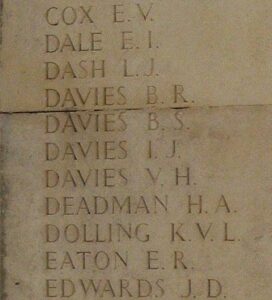
David Davies. This man cannot presently be identified.
Evan Davies, Private, 6096843, The Queens Royal Regiment (West Surrey). Evan was the son of David John and Hannah Jane Davies, of Saron, and served in the 1/7th Battalion, Queens Royal Regiment. The Battalion was part of 131 (Queens) Lorried Infantry Brigade, originally, part of the 44th (Home Counties) Infantry Division and after ‘mobilisation’ in late August 1939 it was originally stationed in and around Guildford, Surrey. It consisted of 1/5th Bn., 1/6th Bn. and 1/7th Bn. Queen’s Royal Regiment. Later in 1939 hard training followed in Dorset and then the Brigade was out on standby to move to Finland, but this did not materialise. The King inspected the 44th (Home Counties) Division in February 1940 and on 2 April the Brigade, embarked at Southampton for Cherbourg and then formed part of the BEF (British Expeditionary Force), 1940. After being evacuated at Dunkirk the brigade was reformed and used for general guard duties, until in May 1942 large drafts were received to bring it up to war establishment. Then on 24 May 1942 it embarked for the Middle East. The convoy called at Freetown where General Sir George Gifford, Queen’s, who was then GOC West Africa, and arrived at Durban at the end of June. From there the ships in the Convoy sailed individually without escort to Aden and on to Egypt. There along with the rest of 44th Division, the brigade disembarked in Egypt early in July 1942. The Brigade trained east of Cairo until it joined the 8th Army in August 1942. Its first action was at the Battle of Alam Halfa. It then became permanently part of the 7th Armoured Division in October 1942 and remained with the Division until the end of the war. During the remainder of the North African campaign the Brigade occupied Tobruk on 12 November 1942 and Benghazi, 350 miles on, eleven days later. Evan was killed here on 24 October 1942, aged 27, and is commemorated on the Alamein Memorial.
Thomas John Davies, Sailor, Merchant Navy. Thomas was born at 7, Bungalow, Ammanford in 1923, and served with the Merchant Navy aboard the Sunderland registered cargo steamer S.S. Brinkburn. On 21 June 1943 Brinkburn was in Convoy TE-22 when she was torpedoed and sunk by the German submarine U-73 west of Algiers, with the loss of 26 lives. Thomas was 20 years old when he died that day and is commemorated on the Tower Hill Memorial, London.
Daniel Isaac Evans, Private, 3960739, North Staffordshire Regiment. Daniel was the son of David and Annie Evans, of Ammanford, and the husband of Emily Lucy Evans, of Saron. He served in the 2nd Battalion North Staffordshire Regiment, which were in France with the BEF at the outbreak of war, and were evacuated from Dunkirk after suffering heavy casualties in the retreat to the coast. After rebuilding in the UK the Battalion moved to North Africa, and fought at El Alamein in late 1942, then took part in the final campaign to drive the Axis forces from North Africa. The campaign began on 8 November 1942, when Commonwealth and American troops made a series of landings in Algeria and Morocco. The Germans responded immediately by sending a force from Sicily to northern Tunisia, which checked the Allied advance east in early December. Meanwhile, in the south, the Axis forces defeated at El Alamein were withdrawing into Tunisia along the coast through Libya, pursued by the Allied Eighth Army. By mid April 1943, the combined Axis force was hemmed into a small corner of north-eastern Tunisia and the Allies were grouped for their final offensive. Daniel was killed around this time, aged 26, on 29 April 1943. He is buried at Massicault War Cemetery, Tunisia.
Dennis James Hughes, Warrant Officer, 1312982, Royal Air Force Volunteer Reserve. Dennis was the son of James and Margaret Ann Hughes, of Saron, and flew in 514 Squadron, RAF, who were equipped with the Avro Lancaster II, based at Waterbeach. On the night of 21 January 1944, Dennis took off in his Lancaster as part of a group of almost 650 bombers, bound for Magdeburg. The group was intercepted by German night fighters on the outward journey, and suffered terrible casualties. Dennis was killed that night, on the morning of 22 January 1944. He was only 22 years old and is commemorated on the Runnymede Memorial, Surrey.
Samuel Leslie Jenkins, Captain, 88225, South Wales Borderers. Samuel was the son of John and Ellen Jenkins, of Carmarthen, and the husband of Jean Rosaleen Jenkins, of Llanarthney. He was a Captain with the South Wales Borderers, before applying for Commando training, and was posted to No. 2 Commando. On 4 March 1944 Samuel and another officer of 2 Commando were on reconnaissance in preparation for a raid on Solta, when Samuel was wounded and captured. He died on 6 March 1944, aged 29, and is buried at Belgrade War Cemetery, Serbia & Montenegro. There is a cross in the Chapel which was presented in Samuel’s memory.
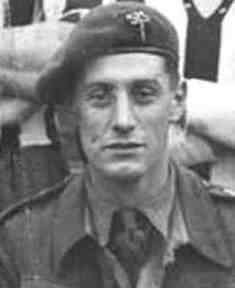
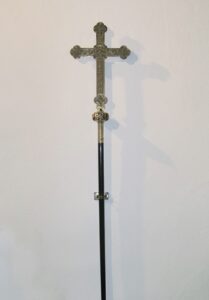
William Leonard Marshall, Private, 5507100, Hampshire Regiment. William was the son of Arthur and Jane Marshall. He married Annette Mary Thomas, of Saron, in 1942. He served with the 2/4th Battalion, Hampshire Regiment, which was attached to the 128th Infantry Brigade, 46th Division. The division left Britain for the Mediterranean in January 1943 in order to take part in Operation Torch and saw heavy fighting in Algeria. The North African campaign was over by May 1943 and the 128th Brigade was reformed. The 2/4th Hampshire’s were split into two Defence Units of two Beach Groups apiece, and tasked with the protection of the landing areas during the Allied landings at Salerno in September 1943. Following the successful landings the battalion became reformed and attached to the 28th Infantry Brigade, 4th Division and took part in the slow advance north through Italy. William was killed during the battalions last major action, the capture of a bridgehead over the Cosina River, on 24 November 1944. He was 31 years old and is buried in Cesena War Cemetery, Italy.
Glyn Price Rees, Engine Room Artificer 4th Class, D/MX 73397, Royal Navy. Glyn was born in Saron on 15 August 1915, the son of Alfred and Martha Rees. He married Mary Gwendoline Davies in 1935 and the couple lived in Glanamman. Glyn served in the Royal Navy aboard HMS Hermione, which was a Dido Class Light Cruiser, which had been commissioned in 1941. Hermione served in the Home Fleet at first, and then took part in escort duties during the Malta Convoys. On 16 June 1942, whilst returning to Alexandria, HMS Hermione was torpedoed by the German submarine U-205, north of Sollum and sank with the loss of 87 of her crew. Among them was Glyn. He was 26 years old, and is commemorated on the Plymouth Naval Memorial, Devon.
Daniel Goronwy Thomas, Flight Sergeant (Air Gunner), 1499060, Royal Air Force Volunteer Reserve. Daniel, known as Ron, was the son of Elias and Rachel Thomas, of Llansadwrn, and served with 617 Squadron, Royal Air Force. The Squadron was made famous during its most daring raid on 16/17 May 1943, when they took part in Operation Chastise, the famous Dambusters Raid. Ron didn’t take part in the Dambusters Raid, but joined the squadron afterwards, as a replacement for the heavy casualties suffered. He was killed in Lancaster PB416, which was on transit from Yagodnik, Russia, when it crashed at 02.15 hours near Nesbyen, Norway on 17 September 1944. Ron was 23 years old, and is buried at Nesbyen Churchyard, Norway.
Daniel Owen Thomas, Flying Officer, 124699, Royal Air Force Volunteer Reserve. Daniel was the son of William Henry and Ruth Thomas, of Ammanford, and served with 83 Squadron, RAFVR. The Squadron were part of RAF Bomber Command, and by 1942 were equipped with the Lancaster Bomber. They had already made a name for themselves, and were transferred to RAF Wyton as part of the elite Pathfinder Force. The Squadron took part in missions over Northern Italy, the Ruhr Valley, and started bombing targets in Hamburg during the first few months of 1943. On the night of 12 June 1943 they were returning from a mission to drop target indicators on Munster, when Daniel’s Lancaster, piloted by Squadron Leader James Eric Swift DFC, was shot down over the English Channel. The whole crew was lost, but the bodies of Swift and another crewman Sgt. J. J. Anderton were washed ashore. Daniel was 26 years old, and is commemorated on the Runnymede Memorial.
Stanley Thomas, Sergeant (Air Gunner), 1836816, Royal Air Force Volunteer Reserve. Stanley was the son of Mr. and Mrs. J. G. Thomas, of Penybank, and served with 298 Squadron, RAFVR. 298 Squadron were equipped with the Halifax, and flew supply dropping missions over occupied Europe, and on D-day towed the Horsa Gliders which landed on Pegasus Bridge, carrying the 6th Airborne Brigade. They continued on re-supply drops throughout the remainder of the war, and also towed Gliders to Arnhem, as part of Operation Market Garden. Stanley was killed when his Halifax was shot down on a drop to supply SOE Agents in Holland, on 13 April 1945. He was 22 years old, and is buried at Amsterdam New Eastern Cemetery.
David John Walters, Sergeant, 1452964, Royal Air Force Volunteer Reserve. David was the son of Owen Pugh Walters and Mary Jane Walters (nee Jones), of Saron. The family had lived in Edgware, Middlesex before returning to Saron after the war. David served with the Royal Air Force Volunteer Reserve and was posted to RAF Abu Sueir, near Ismailia in Egypt. Little else is presently known of him, but he was killed on 19 January 1945, aged 23, and is commemorated on the Alamein Memorial, Egypt.
William Rees Williams, Chief Steward, D/LX21365, Royal Navy. William was born on 12 March 1911, the son of David and Margaret Jane Williams, of 19 Norman Road, Tirydail, Ammanford. He was the husband of Susanna Rebecca Williams, of Saron. He served with the Royal Navy, aboard H.M.S. Punjabi, which was a Tribal Class Destroyer, commissioned in 1939. Immediately at the outbreak of World War 2, Punjabi began to patrol the North Atlantic with the rest of the 6th Destroyer Flotilla. For the first three months, her duties consisted of anti- submarine patrols and fleet screening duties. During the Second Battle of Narvik on 13 April 1940, Punjabi was badly damaged by six shells but was back in action an hour later. On 21 May 1941 it was believed that the German battleship Bismarck was ready to break out into the Atlantic. Confirmation came through on 22 May and the Home Fleet sailed at 22.45. Punjabi though, as part of that Fleet, was not to share in the final cornering of Bismarck. Two days of high speed search soon depleted the destroyers fuel oil and by 24/25, all destroyers had to return to Hvalfiord, Iceland to refuel. Prior to the invasion of Russia by Germany, Force ‘K’ consisting of Punjabi, HMS Aurora, HMS Nigeria and HMS Tartar left Scapa Flow for Spitsbergen with the intention of investigating that island’s use as a naval base, and found that a military occupation of Spitsbergen could be feasible, but the winter ice in the fjords would prohibit the island’s use as an all-year round naval base. After that mission, all of Punjabi’s operations focused on Russian convoys. In January 1942, she was retrofitted at Palmer’s Yarrow Yard and immediately returned to her Home Fleet duties. On 5 March 1942 she joined HMS Ashanti and HMS Bedouin in an abortive hunt for the German battleship Tirpitz. After a second attempt, Punjabi was forced to return to base with disabled steering gear. While on duty with convoy PQ-15 on 1 May 1942, visibility suddenly closed in and the 35,000 ton battleship HMS King George V crashed into Punjabi’s port side. Her stern sank almost immediately, and her depth charges detonated, causing severe injuries to the survivors. Fortunately, Punjabi’s forepart sunk quite slowly thus allowing 169 people to be saved by HMS Martin and HMS Marne. Sadly William was one of the men lost in the tragedy. He was 31 years old, and is commemorated on the Plymouth Naval Memorial, Devon.
